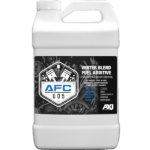AFC Series of Broad Spectrum Diesel Fuel & Gasoline Additives
for Fuel Conditioning, Stabilization, Tank
Cleaning, and Combustion Catalyst
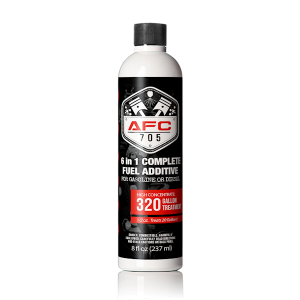

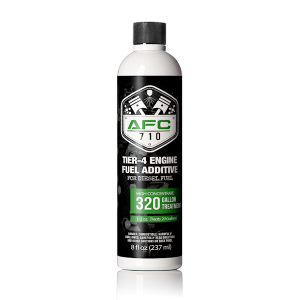


Active Ingredients:
How They Work
Increases horsepower, improves fuel economy, lowers exhaust emissions, remove/prevents carbon deposit buildup
How it works:
The combustion catalyst binds to the hydrocarbon molecules in the fuel and weakens the bonds needed to be broken for energy during the combustion process. By weakening these bonds, more fuel is burnt during each engine stroke that would have otherwise been sent out the exhaust as emissions or contributed to carbon deposit buildup in the engine. In achieving a more complete burn of the fuel, more energy is extracted per drop leading to an increase in power and improved fuel economy.
Stabilizes fuel up to 12 months, maintaining fuel quality for longer periods of time, eliminating the need to drain fuel before storage
How it works:
Fuel instability results in the formation of harmful particulate that can damage injection systems and clog filters. The fuel stabilizer prevents instability by interrupting a chain of reactions that often leads to the formation of particulate. This is achieved through the addition of anti-oxidants that actively combat oxidation, a chemical reaction that occurs when small amounts of dissolved oxygen reacts with the fuel often leading to fuel instability.
Prevents the development of corrosion in the fuel tank and engine to reduce maintenance and increase overall longevity
How it works:
Corrosion can occur in the fuel tank and corresponding plumbing when water present in the fuel reacts with the metal to form rust. To prevent this, corrosion inhibiting compounds attach to the metal surfaces and form a protective barrier, preventing the effects of corrosive agents.
Extends engine life by reducing wear on moving parts through the addition of lubrication compounds in the fuel
How it works:
The lubricity enhancer contains polar molecules that bind to the metallic surfaces of the engine components to form a thin surface film. This film acts as lubricant when two metal surfaces come into contact. By virtue of lubrication, the lubricity enhancer reduces wear, extending the life of engine components.
Available In: AFC-705 Liquid, AFC-710 Liquid, & AFC-805 Liquid
Enhances breakdown of fuel contaminants such as sludge that develop in the tank
How it works:
Unlike a fuel stabilizer that aims to prevent the formation of fuel contaminants, a dispersant works to keep these particulates from clustering into larger clumps that can plug fuel filters and injector tips. By the same mechanism, dispersants can also help breakdown clusters of particulate that have already formed making it a good reactionary measure for contaminated tanks.
Available In: AFC-705 Liquid
Emulsifies water to inhibit the proliferation of microbial (“algae”) contamination in the fuel
How it works:
Surfactants consist of polar compounds that actively emulsify or “pull” separated water molecules into the fuel. By effect, water molecules will remain in solution to later be sent through the engine and safely out the exhaust (in non tier-4 engines). By keeping the water from separating below the fuel you prevent favorable conditions for microbial growth.
Available In: AFC-705 Liquid
Frequently Asked
Questions
AFC Series Mix Ratios
Known
Contaminated
Tank
Preventative
Maintenance
All Liquid Additives
Treatment Ratio
1:2500
1:50000
8-oz Bottle
160 Gal.
320 Gal.
1-Gallon Jug
2,500 Gal.
5,000 Gal.
55-Gallon Drum
2,500 Gal.
5,000 Gal.
One gallon of AFC-705 or AFC-710 cleans a full 5,000-gallon fuel tank for a regular preventative maintenance treatment. If you are treating a tank that is more than five years old for the first time, or you are treating a tank that you know is contaminated, it is recommended that you use a double dose, using one gallon of fuel to 2,500-gallons (see other treatment ratios below). This full spectrum additive package cleans the entire diesel fuel system, restores diesel fuel quality and provides Optimal Diesel Fuel Quality for engines and storage tanks, improving fuel economy, reducing emissions and lowering operating cost, maintenance and down time.
It is generally agreed that most engine failures originate in the fuel tank. Frequent fuel filter changes, fuel dialysis and tank cleaning are generally viewed as good house keeping, and have become accepted as standard periodic maintenance.
The normal aging process of the fuel is often accelerated by microbial contamination, chemical incompatibility and condensation of water in the system. Oxidation, polymerization and stratification will lead to darkening of the fuel, the build up of tank sludge, filter plugging, corrosion, and fuel breakdown. We will see a slimy, jelly like layer develop in the water-fuel interface, while a bio-film is growing on the bottom, walls and baffles of service and storage tanks, inside fuel lines and delivery systems.
The process of fuel breakdown is most severe in the bottom of our tanks. Every time we fill our tanks, we mix and contaminate the fresh fuel with our residual fuel, and add new oxygen, which accelerates the problem. Because we primarily use the higher and therefore dryer layers of the diesel fuel, it is easy to overlook the symptoms of this continuous process of fuel breakdown.
Suddenly we get a wake up call, and experience some or all of these symptoms:
- Clogged filters
- Fouled and Corroded Injectors
- Smoking Engines
- Loss of Power and RPMs
- Fuel Pump Problems
- COMPLETE ENGINE FAILURE
All of this can be prevented by simply monitoring fuel quality, and using the available AXI technology.
The surfactants and dispersants in AXI Fuel Catalyst completely break down and dissolve the tank sludge and bio-film. It eliminates clogged filter elements and recovers the BTU value that would otherwise be lost.
Traditionally tank cleaning meant filtering the fuel in the tank, or removing the fuel for filtration, or complete fuel disposal often in conjunction with opening the tank and physically removing tank sludge and bio-film. All these techniques are time consuming, costly and only partially effective, in particular when we realize that filtration will only remove the suspended debris and has no effect on the bio-film growing on tank walls, bottom and baffles, or on the process of fuel break down. At best we can expect only temporary relief at an extremely high price.
We recommend the use of AXI Fuel Catalyst to completely decontaminate and clean the entire fuel system, with the simultaneous installation of an In-line Fuel Conditioner to insure continuous Optimal Fuel Quality, enhanced combustion, and reduced emissions.
The AFC catalyst enhances and complements the effects of the In-line Fuel Conditioner. You would also use AFC Series Additives if you are beginning a Fuel Maintenance Program that would involve periodically treating a tank with a TK Series Portable, and MTC Series Mobile, or an STS Series 6000 or Series 7000 Automated Fuel Conditioning and Tank Cleaning System. Review the process for using AFC with a circulation system in Guide #5 “Cleaning a Fuel Tank also available at the Guides Menu along the left side of any page on this web site.
When the EPA mandated the switch to 15 ppm of sulfur content in diesel fuel in 2007, introducing the era of Ultra Low Sulfur Diesel (ULSD) Fuel, the agency allowed for a phase-in period, but by 2015, all diesel fuel both on-road and off sold in the U.S. had transitioned to ULSD. This sulfur removal has caused a major problem with microbial growth in diesel tanks, both storage tanks and operating equipment tanks, because the natural biocide provided by the sulfur in the fuel has been substantially eliminated.
Sulfur acts as a natural biocide that had helped prevent microbial growth in diesel fuel tanks. This microbial growth is not algae, although many people think it is. The slimy debris that clogs fuel filters and is visible floating around in fuel is actually a bio-mass that is a byproduct of the reproduction of the microbes that utilize the water in the tank bottom as a habitat, feeding off the additives in the diesel fuel at the fuel-water interface in the tank bottom. Removing the sulfur made the fuel much less resistant to fuel microbes, including fungus, mold, and bacteria.
Microbes, mold and bacteria may be introduced into a fuel tank with a fuel fill-up, but it is more common for this contamination to come in through the air vent. As fuel is used, it is replaced with air drawn into the tank through a vent, and this air contains both moisture and the microbes and fungi that, over time, develops into a real problem. Storage tanks, especially above ground tanks, “breath” as the tank warms during the day and the heated fuel expands, pushing air out of the tank. At night the fuel contracts as the fuel cools, drawing moisture and contaminants in through the vent.
It may take up to nine months for the microbial growth to develop before the fuel starts showing the symptoms of microbial growth:
- Clogged and slimy filters
- Dark hazy fuel
- Floating debris in the tank
- Sludge build-up in the tank bottom
- Loss of power and RPM
- Excessive exhaust smoke
- Corroded, pitted fuel injectors
- A foul odor emitting from the fuel tank
Any of these symptoms indicate a serious fuel problem.

Preventing this situation is critical. The use of an air vent breather that prevents the drawing in of moisture and microbes in through the vent is an absolute must. Desiccant Fuel Tank Breathers contain material that absorbs moisture as the air is drawn into the tank, and filters dust, pollen and other organic components, as well as dirt, grit, and other particulates that carry the micro-organisms, bacterial growth, fungal growth, enzyme activity, yeast, mold, and pollen into your fuel tank. Stopping this flow should be the first step to stopping the problem.
The most critical steps you can take in controlling microbial growth is in robbing the microbes of their habitat. Checking for water on a regular basis (every 30 to 60 days) using Kolor Kut Water Finding Paste and removing any water that is detected will reduce the likelihood of an infestation in your tank, but will not absolutely prevent it as even residual water left behind when a tank bottom is pumped to remove water can harbor an infestation.
Using a device known as a Water Eliminator, available for smaller tanks in a 12″ size and a 31″ version for use in storage tanks, crystals in the Water Eliminator absorbs the water but will not absorb diesel fuel. The water in the bottom of the tank will be held in the device and not spread over the bottom of the tank. At periodic inspections at fuel fills, when the device has absorbed its full capacity of water remove it and replace with another for ongoing protection.
Periodic treatment of fuel with AFC dissolves the bio-mass, and periodic circulation of the fuel is necessary to assure the tanks are clean, free of water, and any microbes left behind is not reproducing. The LG-X Series In-line Fuel Conditioner sees to that.
Unfortunately, by the time you realize you have a problem, the effectiveness of biocides are limited. If a heavy bio-film has accumulated on the inside surface of the tank or other fuel system components, the biocide may not be able to penetrate this film to reach the organisms living deep within the film. You may see short term relief, but the problem quickly returns as the remaining organisms further reproduce.
Frequently, the application of a biocide aggravates the situation and converts what bio-film that is treated into solids, creating a real fuel filter nightmare. The introduction of a biocide into a fuel tank results in the organic materials turning into a grit that settles to the tank bottom. Then, each time you re-fuel, these materials are stirred up and find their way into your fuel line. As a further complication in the use of biocides, the removal of water from a tank bottom that was treated with biocides must be disposed of appropriately because biocides are toxic.
As diesel fuel ages and it is exposed to air, water, and other factors, its heavy-end asphaltene content will become unstable and start to drop out of suspension in the fuel. When old fuel appears dark or even black, this is caused by the agglomeration of the asphaltene component. As these solids grow in size, they drop to the tank bottom and add to the sludge and debris. They clog your fuel filters and the filters turn black. If you have ever looked inside a fuel tank, and the tank bottom appears to be painted with roofing tar, this is what the accumulation of the asphaltene debris looks like.
This asphaltene component is present in all fuels. In the refining process, crude oil is separated into its components based on mass. Lighter components become gasoline, while heavier components of the crude oil becomes diesel fuel, kerosene and other fuels. Heavier still are the components that are the basis for lubricating oils and other petrochemical products, with the heaviest component becoming asphalt that paves our roads (hence the name “asphaltene”)
The AFC will, over a period of time with regular use, clean this accumulation in your tank, and with ongoing circulation through the LG-X Series In-line Fuel Conditioner, either mounted on your fuel line or, with periodic treatments utilizing a TK Series Portable, MTC Series Mobile, FPS Compact or an STS Series Automated Enclosed Fuel Conditioning and Tank Cleaning Systems, will go back into solution, allowing the fuel to regain its “clear and bright” appearance. This returning dark fuel to bright fuel is where the term “Fuel Polishing” originated.
According to Caterpillar, ULSD has a shelf life, even when all basic fuel storage maintenance practices are followed by the distributor, of one year beginning when the diesel fuel leaves the producer, and six months for bio-diesel and blended bio-diesel. At temperatures above 86 deg. F (30 deg. C), diesel and bio-diesel fuel storage life is cut in half.
However, Cat contends that diesel fuels can deteriorate rapidly when fuel is “stressed”. The high pressure (in excess of 30,000 psi) and high temperatures (fuel is used as a coolant for high-pressure fuel injection systems) that the fuel endures as it is repeatedly recirculated back to the fuel tank is responsible for much of fuel degradation. Gums and resins that occur in diesel fuel under these stressful conditions are the result of dissolved oxidation products in the fuel that do not evaporate easily and do not burn cleanly. Excessive gum in the fuel will coat the inside of fuel lines, pumps and injectors and interferes with the close tolerances of the moving parts of fuel systems (Caterpillar’s publication SEBU6251-17 “Cat Commercial Diesel Engine Fluids Recommendations”, Page 45). Google the above publication number, although there may be more recent versions available online.
In today’s low sulfur fuel, many of the fuel components that contribute to the lubricating properties of the fuel have been removed. The components used to formulate the lubricity enhancers in AFC Series Fuel Catalyst work to offset the lower lubricating properties in two different ways, and over two different temperature ranges.
- The first component works by coating the surfaces with a protective lubricating film. This film also acts as a corrosion inhibitor, which keeps the parts clean and free of pits. The film works best at lower temperature up to about 300 deg. C , and is constantly being replenished as it is broken down by friction and heat.
- The second component breaks down large abrasive particles into smaller smoother particles. This component works at temperatures higher than 200 deg C, and continues to work in conjunction with the combustion catalysts once it enters the combustion chamber.
The two components together address corrosion, lubrication and friction problems over the entire engine operating temperature range, and inhibit the formation of acids. AFC lubricity enhancers will not change the fuel specifications in any way. The sulfur content, BTU value and other specifications will remain unchanged.
The principle benefit of AFC lubricity enhancers is the extended life of engine parts that rely on the fuel for lubrication. Keeping these parts operating normally solves many of the problems related to switching from a regular to a low sulfur diesel fuel. A small increase in available power will be noticeable due to lower friction.
Engine parts will be more resistant to acid corrosion and will show less wear due to carbon grit. As a result, engine lubricating oil will stay cleaner much longer. The mineral content, carbon grit, and acid forming compounds in the oil will be much lower. AFC lubricity enhancers will not interfere with crankcase oil additives. Instead, they may actually help them to do a better job.
As in any maintenance situation, the effectiveness of AFC lubricity enhancers does not replace good maintenance practices. However, its use will significantly reduce maintenance requirement and down time, while extending equipment life.
The use of AFC is highly recommended, in particular in situations with low sulfur, or low lubricity fuel. The lubricity enhancer and corrosion inhibitor package in the catalyst are designed to improve engine performance and increase the life of key engine parts while saving in fuel and reducing harmful emissions.
Review the Article on this web site “AFC Series Fuel Catalyst, Fuel Stabilizer and Tank Cleaning Additive — A Technical Discussion —” for a more complete and technical discussion of AFC Series Diesel Fuel Additives
The AFC combustion catalyst compound is the deposit control and combustion component surface modifier which acts as a catalyst breaking down carbon deposits. The deposits are reduced through a process called de-carboxylation, the release of a carbon atom in the form of C02.
The relatively cool surface temperature of the deposit layer restricts de-carboxylation from happening naturally in an internal combustion engine. The catalyst reduces the temperature needed for de-carboxylation from about 600o C to about 200o C. It enables the chemical reaction to occur on the cooler surface of the deposits.
The interaction of the catalyst with the exposed surface of the deposits causes the release of a water molecule and a carbon molecule in the form of CO2. The deposit surface re-oxidizes to a carboxyl state and continues interacting with the catalyst molecules.
The effectiveness of AFC in removing carbon deposits is related to the surface area and mass of the deposits, the amount of new deposit material being formed during combustion and the amount of catalyst present. Results will be different for each combustion chamber because of its unique history of deposit buildup. However, due to the similarity in basic chemical reactions the end result will be the same in spite of all the differences.
Once an old engine is clean, the minimum amount of catalyst needed is the amount required to inhibit new deposit formation. A new engine needs only this minimum amount to remain clean, and a dirty engine will not get any worse. The exact amount in each case depends on the size of the combustion chamber and the fuel being used. The concentration of AFC catalyst in treated fuel is higher than the necessary minimum requirement. It ensures zero new deposit formation, and the complete removal of all old deposits.
The optimum amount to use in a dirty engine is the amount necessary to inhibit new deposit formation plus completely saturate all exposed surfaces of existing deposits. Excess amounts of catalyst beyond the surface saturation point, will not speed up the deposit removal process.
The concentration of the active ingredient has been calculated such that the majority of the dirty engines in operation will receive a sufficient amount of combustion catalyst required for total deposit surface saturation.
Review the Article on this web site “AFC Series Fuel Catalyst, Fuel Stabilizer and Tank Cleaning Additive — A Technical Discussion —” for a more complete and technical discussion of AFC Series Diesel Fuel Additives
See The Article under the Articles Link to understand how Blessey Marine Cut Costs and Cut Emissions
Advertisement
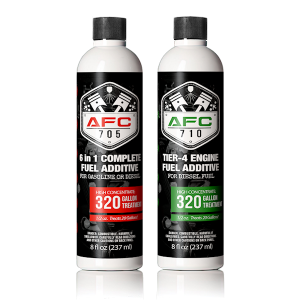 The AFC Series of Fuel & Tank Cleaning Additives are a line of fuel additives that are High Performance, Broad Spectrum Additives in a Concentrate that removes and prevents carbon-based deposits in the combustion chamber, eliminates microbial contamination, clogged filters and the build up of sludge in fuel storage and delivery systems.
The AFC Series of Fuel & Tank Cleaning Additives are a line of fuel additives that are High Performance, Broad Spectrum Additives in a Concentrate that removes and prevents carbon-based deposits in the combustion chamber, eliminates microbial contamination, clogged filters and the build up of sludge in fuel storage and delivery systems.
These industrial quality additives incorporate fuel stabilizers and intense cleaning agents that prevent sludge build-up in tanks, improves combustion, reduces harmful emissions, and eliminate the need for expensive and toxic biocides.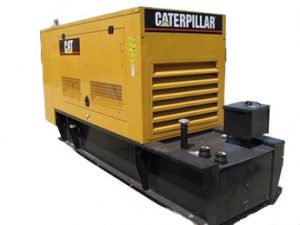
The AFC family of additives are formulated for use in diesel, gasoline, bio-fuels, kerosene and Heavy Fuel Oil (also known as heavy fuel oil or residential fuel oil).
AFC Fuel Catalyst is not like other additives readily available at truck stops, auto and truck parts retailers, marine supply stores, or sold by numerous on-line suppliers.
AFC is formulated and blended for the focused dual-purpose of:
First – working hand-in-hand with LG-X Series Fuel Conditioners, any of the TK Portable, the MTC Series Mobile Systems, the FPS Series of Compact, or the STS Series of Advanced Automated Systems, cleaning fuel tanks in preparation for periodic circulation and treatment of the fuel; and
Second – as a continuing part of a complete Fuel Management Plan to maintain the cleanliness of storage tanks and fuel systems and assuring that your fuel maintains Optimal Fuel Quality, that we define as fuel that is like it was when it left the refinery, for as long as you depend on the fuel to efficiently operate your equipment.
The AFC Series Fuel Catalyst Family of Products
The AFC Fuel Catalyst Family of Products consist of three products that address three very specific uses.
AFC-705 Diesel Fuel Catalyst — The AFC-705 Fuel Catalyst is a tank cleaning, fuel stabilizer additive that restores Optimal Fuel Quality and preserves the integrity of stored fuel up to 12 months. AFC-705 is formulated for use in fuel (both diesel and gasoline) that will supply engines that are not required to meet Tier 4 requirements for diesel engines of the U.S., generally those diesel engines manufactured prior to 2007, but Tier 4 requirements were phased in between 2008 and 2015 for various applications. The active ingredients are Combustion Catalysts, Dispersants, Surfactants, Corrosion Inhibitors, and Lubricity Enhancers.
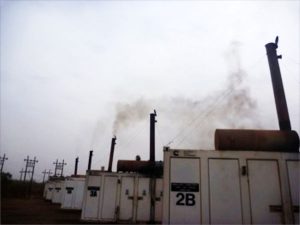
AFC-710 Diesel Fuel Catalyst — The AFC-710 Diesel Fuel Catalyst is available in both a liquid and a powder form, providing great flexibility in how you treat your diesel fuel, and is Tier 4 Compliant (made for use in diesel engines that were manufactured after 2006). AFC-710 has a chemical affinity to the hydrocarbons in your diesel fuel, helping your engine tap into your fuel’s full potential by burning it more completely. While it is doing so, it’s also cleaning your fuel system, from the fuel tank to your injectors, to your combustion chamber, and through to your exhaust. You can expect AFC Series Fuel Additives to improve your fuel economy, increase your horsepower, add engine lubricity, and extend DEF and UREA lifespan, especially if you have not regularly used a fuel additive in the past. AFC-710 Fuel Catalyst meets EPA standards and will work with other additives – but you won’t likely need them anymore. Active Ingredients include Combustion Catalysts, Dispersants, Corrosion Inhibitors, and Lubricity Enhancers.
AFC-710 Powder Form is a unique and powerful Tier 4 compliant broad-specturm fuel additive that performs equivalent to the AFC-710 liquid variation, but is easier to handle and transport, especially when shipping by air freight.
The Powder form of AFC-710 is available with the following treatments:
- P600 Package (40 gram): treats 600 gallons (available by special order only – contact us for pricing and lead time)
- P2000 Package (140 Grams): treats 2000 gallons (available by special order only – contact us for pricing and lead time)
- P5000 Package (334 grams): treats 5000 gallons
AFC-805 Anti-Gelling Broad Spectrum Fuel Additive — AFC-805 is a unique and powerful fuel additive specifically formulated as part of a preventative fuel maintenance program, and is ideal for use in bulk storage fuel tanks in cold weather environments. AFC-805 effectively decontaminates and cleans an engine’s entire fuel and injection system. It continues to work in storage tanks cleaning and stabilizing fuel for up to 12 months with a single dose. AFC-805 is ideally used for cold weather applications where there is long term fuel storage, such as bulk fuel farms, winterized recreational and work boats, and smaller engines. Active Ingredients include Combustion Catalysts, Dispersants, Anti-Gelling Agents, Corrosion Inhibitors, and Lubricity Enhancers.
How the AFC Series Family of Products are Different
The formulation of AFC-705 Diesel Fuel Additive includes surfactant and dispersant components that break down and dissolve sludge and organic debris. Prior to adding AFC-705 to your tank as part of a fuel conditioning and tank cleaning undertaking, it is recommended that a circulation system or other means be used to remove free water from the tank bottom for proper disposal. However, it is difficult to be assured that all water is removed during this initial phase of the tank cleaning process regardless of the means used. The surfactant that is a component in the AFC-705 will emulsify this residual water that remains in the tank bottom after an active water removal process up into the fuel for removal in the subsequent circulation process with the use of water block coalescing filters, returning the fuel to a “clear and bright” state from the cloudy, foggy looking fuel that has water mixed with the fuel (for more information on the circulation process, see the “Cleaning a Fuel Tank” Guide. However, the surfactant components of the formulation are not in compliance with the requirements of Tier 4 additives.
The formulation of AFC-710 is a unique and powerful Tier 4 compliant broad-spectrum additive concentrate that, in combination with good housekeeping, will stabilize your fuel, prevent sludge build-up, and eliminate the need for expensive and toxic biocides. It includes in its formulation combustion catalysts, dispersants, corrosion inhibitors and lubricity enhancers.
AFC-805 enhances the breakdown and removal of sludge, slime, and bio-fouling from tank walls and baffles in fuel tanks, and has components that make it ideal for use in bulk storage fuel tanks in cold weather environments. AFC-805 is compliant with Tier 4 Requirements.
All AFC Catalyst additives will accelerate the tank cleaning and fuel conditioning process when used with the TK Series Portable, MTC Series Mobile, the FPS Compact, or Advanced Automated Fuel Conditioning and Tank Cleaning System. It will effectively decontaminate and clean the entire fuel and injection system and continues to work in storage tanks cleaning and stabilizing fuel for six months or longer.
AFC Benefits Explained
The benefits of using AXI Fuel Catalyst are derived from its unique formulation of dispersants, surfactants, combustion enhancers and deposit surface modifiers, targeting problems of contaminated fuel systems in storage tanks and deposits in engines, turbines and burners.
- Remove Engine Deposits — AFC combustion catalyst removes deposits by interacting with the surface of the deposit, lowering the energy of activation of its chemical bonds. This allows the release of carbon in the form of C02 at the lower temperatures.
- Prevent Deposit Formation — The AFC catalytic components inhibit the agglomeration process from forming heavy deposits. The agglomeration process is stopped at the primary and secondary particle formation phase, which results in smaller, lighter particles.
- Reduce Fuel Consumption — Deposits in the combustion chamber absorb and protect the fuel from complete combustion. AFC catalyzes the combustion process. It destroys and removes deposits, which leads to the more efficient conversion of the fuel to C02. The surfactant component in AFC reduces the fuel droplet size, which enhances the combustion process, burning a higher percentage of the fuel before the exhaust valve opens. AFC treated fuel immediately reduces fuel consumption by 5 to 10% in comparison to fuel used in high mileage engines that have not been treated with combustion chamber cleaners or additives with similar components.
- Reduce Emissions. — As deposits are removed, the emissions of CO, NOx, SOx, HC and particulates are drastically reduced.
- Reduce Carbon Content of Ash. — The catalyst interferes with the agglomeration of combustion by-products by enhancing C02 production. With less carbon available to end up in the ash complex, the amounts of ash or soot will be significantly reduced.
- Cooler Exhaust, Lower NOx. — Fuel has a limited amount of energy that becomes available during combustion through the production of C02. The catalytic components in AFC enhance the combustion process. When more of the fuels’ energy is released during the combustion phase, less energy will be available to be released during the exhaust phase. The difference in energy release correlates to a temperature difference. Higher energy release in the combustion chamber means lower energy release during the exhaust phase, which results in cooler exhaust, lowering the production of NOx.
- Extend lube-oil life. — AFC treated fuel produces smaller and less abrasive particles, which in connection with the removal of deposits, result in cleaner, longer lasting lubrication oil, and leads to reduced engine wear, less maintenance and down time, lowering operating cost.
- Extend Equipment life. — Engine life can be more than doubled as the result of complete deposit removal, cleaner oil and reduced friction. Injectors, valves, rings and other associated parts show little sign of wear, even after extended use.
- Enhance Fuel Lubricity — With the AFC’s Lubricity Enhancers, engine components that depend on the lubricity of diesel fuel during operations will last longer.
- Inhibiting Corrosion — With the AFC Corrosion Inhibitor, injectors and other components in the fuel system will last longer and maintain optimal performance.
Registration
AFC Additives are registered with the United States Environmental Protection Agency. Click Here to review the list of Registered Gasoline and Diesel Additives (use “control F” and type “AFC” to go to the listing for AFC Additives).



